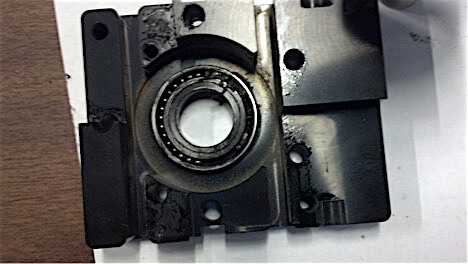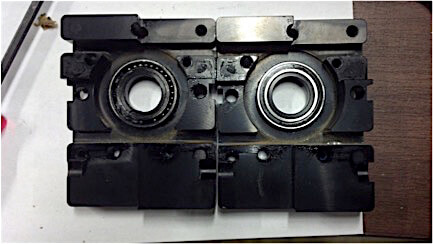News
Are you finding blackened grease patterns or craters on your bearings, causing damage and unplanned machine downtime? This is a phenomenon known as electrical discharge.

Are you hearing unusual noises or seeing blackened grease leaking out of your pulley housings resulting in unplanned machine downtime? If you are, you’re not alone. Your actuator may be degrading due to a phenomenon known as electrical discharge (ED). Stray electrical voltages are traveling from motor shafts through couplings, pulleys, bearings and housings in a search for ground. Since ball bearings are rolling contacts with lubricant between surfaces, the voltage arcs the gap and causes material erosion, lubricant failure, heat and ultimately pre-mature bearing failure. This damage can reduce the life of bearings that should last 6 to 10 years to as little as 2 to 6 months. Your root cause investigation should focus on the motor grounding system as voltage discharges as low as 3.2 volts will cause current discharges across a ball bearing and raceway lubricant gap.
Electrical Discharge Machining, sometimes called “spark machining” is a common manufacturing process where material removal is done by triggering a rapidly recurring current discharge between two electrodes separated by a dielectric liquid and subjected to an electrical voltage. One of the electrodes is the part being machined and the other is the “tool” electrode typically a wire or carbon shape. The gap between each electrode is precisely controlled and the dielectric liquid fills this gap. As voltage is applied and increased, the intensity of the electrical field in the gap rises and becomes stronger than the dielectric liquid allowing current to flow or arc across the gap. As a result, material is removed from each electrode and carried away by the dielectric fluid. Performing this arcing at a high frequency results in an efficient erosion machining process that is very good for hardened materials.
Whereas EDM is a practical manufacturing process, it is not desirable in Motion Control systems and applications.
Stage One:

At first, the continuous arcing will start pitting the bearing raceways and reduce the ball diameter. Ball retainers will also start eroding and break apart. The heat builds due to arcing and friction causing the grease lubrication to breakdown and become contaminated with metal particulate. Blackened grease may leak out of the bearing and be visible on the pulley housing and pulley shaft.
Stage Two:
As the bearing degrades and becomes unlubricated, heat and friction build causing metal to metal contact noise. If the actuator drive shaft is decoupled from the motor, you may feel a roughness or bumpiness when rotating the drive shaft. The electrical discharge continues and works its way to all the bearings in the actuator as these are the points of arcing.
Stage Three:
As the bearings degrade (balls, retainer cage and polymer seals disappear) and become non-functional the actuator will begin running erratic and make significant noise. In a fully catastrophic case there are no bearings remaining and the pulley is unsupported, the actuator timing will be compromised and other parts of the machine system will be affected.
Determining if your actuator has been subjected to Electrical Discharge (ED) damage:
Download Macron Dynamics’ Guide: Maximizing Bearing Life in Linear Actuators to learn how you can prevent electrical erosion and prevent premature failure of your bearings.
Stay Updated
Want to keep up on Macron Dynamics technical data and updates? Subscribe below.
We've got some fantastic news to share — We are not affected by the recent tariffs.
Macron Dynamics is proud to give back to the community by donating one of our gantry systems for educational use...
Meet Macron Dynamics new Director of Operations, Samuel J. Riccio, who is an industrial automation industry expert for semiconductors and...
We've got some fantastic news to share — We are not affected by the recent tariffs.
As a proud USA-based company where all our Engineering, Manufacturing and Application Support is located in Croydon, PA.
We're thrilled to let you know:
Whether you're a longtime customer (thank you for your continued support!) or someone we haven't worked with yet — we'd love to connect and show you what sets us apart.
Let's grow together — tariff-free and stress-free.